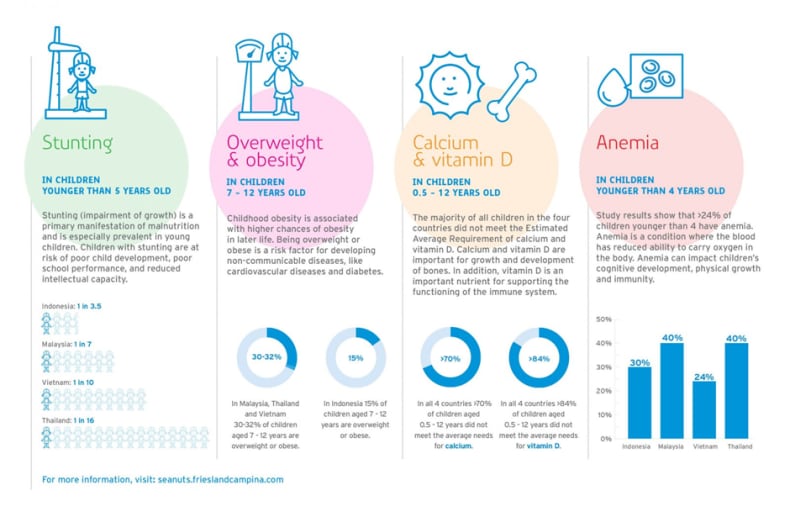Fresh research supported by FrieslandCampina has highlighted the impact of the ‘tripe burden’ of malnutrition on children in Southeast Asia. Understood as the coexistence of undernutrition, micronutrient deficiencies and overweight/obesity, the triple burden was put under the microscope in a large-scale study of nearly 14,000 children, aged six months to 12 years.
Following on from the 2012 South East Asian Nutrition Surveys (SEANUTS I), the study was conducted between 2019 and 2021 by leading universities and research institutes in Indonesia, Malaysia, Thailand and Vietnam.
Overall, this second study (SEANUTS II) shows that stunting and anaemia still exist, especially in younger children. In Indonesia, for example, one in every 3.5 children under five years of age were stunted. Meanwhile, anemia was found in 24% of children under four years old in the region, a figure that rose as high as 40% in Thailand and Malaysia.
For the older children, a higher prevalence of overweight and obesity was detected. In Malaysia, Thailand and Vietnam, 30-32% of seven- to 12-year-olds were either obese or overweight.
“Healthy nutrition is about balance, moderation and variety. If children don’t get the nutrition they need, they won’t grow and develop properly,” stated Dr. Poh Bee Koon, Principal Investigator for SEANUTS II in Malaysia and Professor of Nutrition at UKM’s Faculty of Health Sciences, Centre for Community Health Studies.
“These numbers emphasise an urgent need to improve food security, as well as the availability of food products that meet the children’s needs, thus increasing access to healthy nutrition,” she stressed.

The consequences of malnutrition in SE Asia
Speaking at a conference to probe the implications of SEANUTS II research last week, Prof Muhammad Yazid Jalaludin of the University Malaya outlined the impact that the triple burden has on children in terms of stunting, wasting and overweight.
Malnutrition effects all regions globally. Worldwide 38.9m children under five were overweight in 2020, 149.2m under-fives were stunted and 45.4m were affected by wasting. However, the number of children under five-years-old who suffer from these issues is disproportionately high in Asia and Africa, the conference was told.
In 2020, more than half (53%) of all stunted children under five lived in Asia and 41% lived in Africa. More than two-thirds (70%) of under fives affected by wasting lived in Asia and more than one quarter (27%) lived in Africa. Meanwhile 48% of children under five who were overweight lived in Asia and 27% lived in Africa, Prof Jalaludin revealed.
“We know that nutrition [is a] key factor to avoid the problems of stunting, wasting and overweight,” he noted, pointing to the importance of ‘dietary diversity’. “With the improvement of dietary diversity this would ensure children would receive all the nutrients or non-nutrients they need to grow, stay healthy and reach their development potential. It will also prevent undernutrition including micronutrient deficiencies such as lacking iron, zinc or vitamin A,” the University of Malaya expert stressed.
Nutrient deficiencies were a significant problem identified in the SEANUTS II study, which suggested 'most children' in the four countries did not meet the average needs of calcium and vitamin D intake. “More than 70% of the children in all four countries did not meet the average needs for calcium and more than 84% did not meet the average vitamin D requirements,” detailed Dr Poh Bee Koon.
Dairy protein intake and malnutrition in SE Asia
Prof Jalaludin singled out the importance of protein intake for children to reach their growth potential. He stressed that it isn't just about how much protein is in the diet, the protein quality is an important factor determining health outcomes.
According to the nutrition expert, the average height in developing countries correlates with ‘protein quantity’ while the average height in developed economies relates to the ‘protein quality’ in children’s diets. Low protein quality in some ‘highly developed’ SE Asian countries explains low height averages in those areas, he suggested.
The need to deliver all nine essential amino acids in a form that is readily digestible means that animal proteins, especially dairy, could play an important role in improving nutritional outcomes for children in SE Asia, Prof Jalaludin argued. “Animal protein, in particular milk, is important to support growth as it contains the nine essential amino acids, whose utilisation is dependent of the availability of all the nine EAAs.”

Dr Khanh Tran Van, from the Micronutrient Department at the National Institute of Nutrition in Vietnam, agreed that increased consumption of milk and dairy could make an important contribution to combat the development of chronic diseases and improve childhood nutrition in the region.
“Milk and dairy contribute to meeting nutrient recommendations and protect against the most prevalent chromic diseases,” she told the audience, citing research linking dairy consumption with reduced risk of childhood obesity, no or reduced risk of type 2 diabetes and cardiovascular disease, and benefits for bone mineral density.
FrieslandCampina working to fill nutritional gaps
FrieslandCampina, the European dairy cooperative that commissioned and sponsored the study, said that the triple burden of malnutrition and the consequences this has for children in SE Asia mean it is a ‘matter of great importance’ that nutritional gaps are filled with ‘proper nutrition interventions and educational programmes’.
“Research is key to getting a better understanding of local nutritional needs. The results from this study will help FrieslandCampina in developing better and affordable products that meet the nutritional needs of children and in setting up programmes to promote a well-balanced diet and active lifestyle in collaboration with local authorities, health workers and schools,” said Margrethe Jonkman, Global Director of Research & Development at FrieslandCampina.
Describing the research as a 'milestone' in understanding the nutrition and health status of children in Southeast Asia, Jonkman said: “The collected information is key to develop programs and dairy products to support the nutritional health status of young children.”




